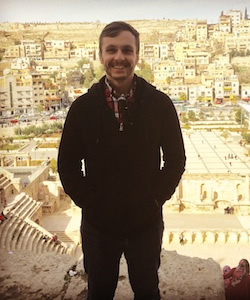Members of all Abrahamic religions revere the Holy Land, an area encompassing Israel and Palestine, as well as parts of Syria, Lebanon, and Jordan. Last week, I was lucky enough to tour the biblical sites of western Jordan. After a short bus ride from Amman, we traveled to Al-Maghtas, the location where John the Baptist baptized Jesus. While both Israel and Jordan claim Jesus’ baptism site rests within their respective borders, Al-Maghtas is recognized as a UNESCO World Heritage Site.
There’s a funny sort of irony in the discrepancy between the two competing claims. Israel, an ethnically Jewish state, and Jordan, a Muslim state, both stake claims that Jesus, Christianity’s messiah, was baptized on their bank of the Jordan River. The river is the site of a number of baptisms on both sides; we personally witnessed a group of Christians on the Israeli side of the bank performing a number of baptisms, full of celebration and cheers.
The Jordan River itself was a hotly contested area in recent history. During the 1967 War, the area of the baptism site (and the banks of the Jordan River more generally) was heavily mined due to its proximity to the front lines. The Israel-Jordan peace treaty of 1994 spurred the demining of the area, which now serves as a major religious and tourist site in the region.
Even today, the tension is in many ways palpable on the bank of the River Jordan. We passed through a checkpoint to reach the site, saw an armored vehicle with a mounted machine gun on the walk over to the river, and met several Jordanian soldiers sitting nearby the bank of the Jordan itself. While we couldn’t see any Israeli soldiers on the other side of the Jordan, I wouldn’t be surprised if there was an equally impressive force across the river.
It’s strange to think of the great weight given to state borders, especially at a site like this. The natural border between the two countries feels almost arbitrary. Perhaps 25 feet wide, it would take less than a minute to swim across to the other side, were it not for two floating boundaries serving as artificial borders in the Jordan River.
After dipping our feet into the Jordan River, we drove to the top of Mount Nebo, the site where Moses saw the Promised Land for the first time. From the summit, you can see Jericho and the Dead Sea, as well as Jerusalem itself on a clear day. There remains a monument commemorating Moses on the mountain, though scholars disagree on Moses’ actual burial site.
Shortly afterwards, we drove to the city of Madaba, well known for its beautiful Byzantine and Umayyad mosaics. After a delicious brunch, we visited the Saint George Church, where the famous Madaba Mosaic Map remains on the church’s floor. Dating back to the sixth century, the map depicts a number of famous biblical sites, including the baptismal site, the Nile Delta, the Dead Sea, and Jerusalem, among other sites. The intricate detailing of the map, estimated to have over two million colored stones within it, is awe-inspiring.
Gazing at the many mosaics within the church fills you with a sense of wonder and deep respect for the creator of the map and his deep commitment to both his work and his faith. The power of religion and faith, noted especially in Jordan and the surrounding areas of the region, is breathtaking and thought-provoking. For thousands of years, the Abrahamic religions have played an integral role in shaping society and daily life. To walk among the living history all around us is an honor and a privilege not to be taken lightly, neither for tourists nor locals.

